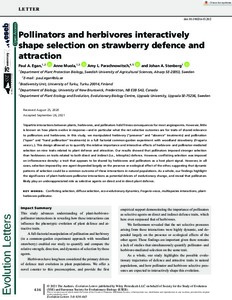Pollinators and herbivores interactively shape selection on strawberry defence and attraction
Egan Paul A.; Muola Anne; Parachnowitsch Amy L.; Stenberg Johan A.
https://urn.fi/URN:NBN:fi-fe2022012710686
Tiivistelmä
Tripartite interactions between plants, herbivores, and pollinators hold fitness consequences for most angiosperms. However, little is known on how plants evolve in response-and in particular what the net selective outcomes are for traits of shared relevance to pollinators and herbivores. In this study, we manipulated herbivory ("presence" and "absence" treatments) and pollination ("open" and "hand pollination" treatments) in a full factorial common-garden experiment with woodland strawberry (Fragaria vesca L.). This design allowed us to quantify the relative importance and interactive effects of herbivore- and pollinator-mediated selection on nine traits related to plant defence and attraction. Our results showed that pollinators imposed stronger selection than herbivores on traits related to both direct and indirect (i.e., tritrophic) defence. However, conflicting selection was imposed on inflorescence density: a trait that appears to be shared by herbivores and pollinators as a host plant signal. However, in all cases, selection imposed by one agent depended largely on the presence or ecological effect of the other, suggesting that dynamic patterns of selection could be a common outcome of these interactions in natural populations. As a whole, our findings highlight the significance of plant-herbivore-pollinator interactions as potential drivers of evolutionary change, and reveal that pollinators likely play an underappreciated role as selective agents on direct and in direct plant defence.
Kokoelmat
- Rinnakkaistallenteet [27094]
